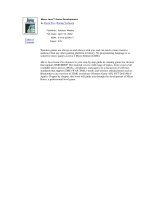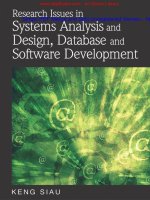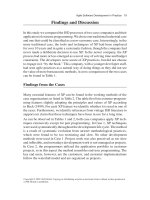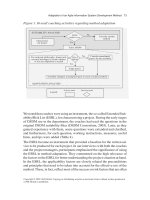Critical systems development
Bạn đang xem bản rút gọn của tài liệu. Xem và tải ngay bản đầy đủ của tài liệu tại đây (94.83 KB, 21 trang )
©Ian Sommerville 2004 Software Engineering, 7th edition. Chapter 20 Slide 1
Critical systems development
©Ian Sommerville 2004 Software Engineering, 7th edition. Chapter 20 Slide 2
Objectives
To explain how fault tolerance and fault
avoidance contribute to the development of
dependable systems
To describe characteristics of dependable
software processes
To introduce programming techniques for
fault avoidance
To describe fault tolerance mechanisms and
their use of diversity and redundancy
©Ian Sommerville 2004 Software Engineering, 7th edition. Chapter 20 Slide 3
Topics covered
Dependable processes
Dependable programming
Fault tolerance
Fault tolerant architectures
©Ian Sommerville 2004 Software Engineering, 7th edition. Chapter 20 Slide 4
Software dependability
In general, software customers expect all
software to be dependable. However, for
non-critical applications, they may be willing
to accept some system failures.
Some applications, however, have very high
dependability requirements and special
software engineering techniques may be
used to achieve this.
©Ian Sommerville 2004 Software Engineering, 7th edition. Chapter 20 Slide 5
Dependability achievement
Fault avoidance
• The system is developed in such a way that human error
is avoided and thus system faults are minimised.
• The development process is organised so that faults in
the system are detected and repaired before delivery to
the customer.
Fault detection
• Verification and validation techniques are used to
discover and remove faults in a system before it is
deployed.
Fault tolerance
• The system is designed so that faults in the delivered
software do not result in system failure.
©Ian Sommerville 2004 Software Engineering, 7th edition. Chapter 20 Slide 6
Diversity and redundancy
Redundancy
• Keep more than 1 version of a critical component
available so that if one fails then a backup is available.
Diversity
• Provide the same functionality in different ways so that
they will not fail in the same way.
However, adding diversity and redundancy adds
complexity and this can increase the chances of
error.
Some engineers advocate simplicity and extensive V
& V is a more effective route to software
dependability.
©Ian Sommerville 2004 Software Engineering, 7th edition. Chapter 20 Slide 7
Diversity and redundancy examples
Redundancy. Where availability is critical
(e.g. in e-commerce systems), companies
normally keep backup servers and switch to
these automatically if failure occurs.
Diversity. To provide resilience against
external attacks, different servers may be
implemented using different operating
systems (e.g. Windows and Linux)
©Ian Sommerville 2004 Software Engineering, 7th edition. Chapter 20 Slide 8
Fault-free software
Current methods of software engineering now
allow for the production of fault-free software, at
least for relatively small systems.
Fault-free software means software which
conforms to its specification. It does NOT mean
software which will always perform correctly as
there may be specification errors.
The cost of producing fault free software is very
high. It is only cost-effective in exceptional
situations. It is often cheaper to accept software
faults and pay for their consequences than to
expend resources on developing fault-free software.
©Ian Sommerville 2004 Software Engineering, 7th edition. Chapter 20 Slide 9
Fault-free software development
Dependable software processes
Quality management
Formal specification
Static verification
Strong typing
Safe programming
Protected information
©Ian Sommerville 2004 Software Engineering, 7th edition. Chapter 20 Slide 10
Fault removal costs
Few
Number of residual err ors
Many Very fe w
©Ian Sommerville 2004 Software Engineering, 7th edition. Chapter 20 Slide 11
Dependable processes
To ensure a minimal number of software
faults, it is important to have a well-defined,
repeatable software process.
A well-defined repeatable process is one that
does not depend entirely on individual skills;
rather can be enacted by different people.
For fault detection, it is clear that the process
activities should include significant effort
devoted to verification and validation.
©Ian Sommerville 2004 Software Engineering, 7th edition. Chapter 20 Slide 12
Dependable process characteristics
Documentable Theprocess should have a defined process model that sets out
the activities in the process and the documentation that is to be
produced during these activities.
Standardised A comprehensive set of software development standards that
definehow the software is to be produced and documented
should be available.
Auditable Theprocess should beunderstandable by people apart from
process participants who can check that process standards are
being followed and make suggestions for process improvement.
Diverse Theprocess should include redundan t and diverse verification
and validationactivities.
Robust Theprocess should beable to recover from failures of
individual process activities.
©Ian Sommerville 2004 Software Engineering, 7th edition. Chapter 20 Slide 13
Validation activities
Requirements inspections.
Requirements management.
Model checking.
Design and code inspection.
Static analysis.
Test planning and management.
Configuration management, discussed in
Chapter 29, is also essential.
©Ian Sommerville 2004 Software Engineering, 7th edition. Chapter 20 Slide 14
Dependable programming
Use programming constructs and techniques
that contribute to fault avoidance and fault
tolerance
• Design for simplicity;
• Protect information from unauthorised access;
• Minimise the use of unsafe programming
constructs.
©Ian Sommerville 2004 Software Engineering, 7th edition. Chapter 20 Slide 15
Information protection
Information should only be exposed to those parts of
the program which need to access it. This involves
the creation of objects or abstract data types that
maintain state and that provide operations on that
state.
This avoids faults for three reasons:
• the probability of accidental corruption of information is
reduced;
• the information is surrounded by ‘firewalls’ so that
problems are less likely to spread to other parts of the
program;
• as all information is localised, you are less likely to make
errors and reviewers are more likely to find errors.
©Ian Sommerville 2004 Software Engineering, 7th edition. Chapter 20 Slide 16
A queue specification in Java
interface Queue {
public void put (Object o) ;
public void remove (Object o) ;
public int size () ;
} //Queue
©Ian Sommerville 2004 Software Engineering, 7th edition. Chapter 20 Slide 17
Signal declaration in Java
class Signal {
static public final int red = 1 ;
static public final int amber = 2 ;
static public final int green = 3 ;
public int sigState ;
}
©Ian Sommerville 2004 Software Engineering, 7th edition. Chapter 20 Slide 18
Safe programming
Faults in programs are usually a
consequence of programmers making
mistakes.
These mistakes occur because people lose
track of the relationships between program
variables.
Some programming constructs are more
error-prone than others so avoiding their use
reduces programmer mistakes.
©Ian Sommerville 2004 Software Engineering, 7th edition. Chapter 20 Slide 19
Structured programming
First proposed in 1968 as an approach to
development that makes programs easier to
understand and that avoids programmer errors.
Programming without gotos.
While loops and if statements as the only
control statements.
Top-down design.
An important development because it promoted
thought and discussion about programming.
©Ian Sommerville 2004 Software Engineering, 7th edition. Chapter 20 Slide 20
Error-prone constructs
Floating-point numbers
• Inherently imprecise. The imprecision may lead to invalid
comparisons.
Pointers
• Pointers referring to the wrong memory areas can corrupt
data. Aliasing can make programs difficult to understand
and change.
Dynamic memory allocation
• Run-time allocation can cause memory overflow.
Parallelism
• Can result in subtle timing errors because of unforeseen
interaction between parallel processes.
Recursion
• Errors in recursion can cause memory overflow.
©Ian Sommerville 2004 Software Engineering, 7th edition. Chapter 20 Slide 21
Error-prone constructs
Interrupts
• Interrupts can cause a critical operation to be terminated
and make a program difficult to understand.
Inheritance
• Code is not localised. This can result in unexpected
behaviour when changes are made and problems of
understanding.
Aliasing
• Using more than 1 name to refer to the same state
variable.
Unbounded arrays
• Buffer overflow failures can occur if no bound checking on
arrays.
Default input processing
• An input action that occurs irrespective of the input.
©Ian Sommerville 2004 Software Engineering, 7th edition. Chapter 20 Slide 22
Exception handling
A program exception is an error or some
unexpected event such as a power failure.
Exception handling constructs allow for such
events to be handled without the need for
continual status checking to detect exceptions.
Using normal control constructs to detect
exceptions needs many additional statements to be
added to the program. This adds a significant
overhead and is potentially error-prone.
©Ian Sommerville 2004 Software Engineering, 7th edition. Chapter 20 Slide 23
Exceptions in Java 1
class SensorFailureException extends Exception {
SensorFailureException (String msg) {
super (msg) ;
Alarm.activate (msg) ;
}
} // SensorFailureException
©Ian Sommerville 2004 Software Engineering, 7th edition. Chapter 20 Slide 24
Exceptions in Java 2
class Sensor {
int readVal () throws SensorFailureException {
try {
int theValue = DeviceIO.readInteger () ;
if (theValue < 0)
throw new SensorFailureException ("Sensor failure") ;
return theValue ;
}
catch (deviceIOException e)
{
throw new SensorFailureException (“ Sensor read error ”) ;
}
} // readVal
} // Sensor









